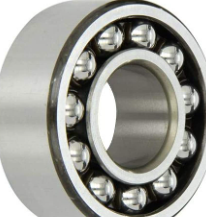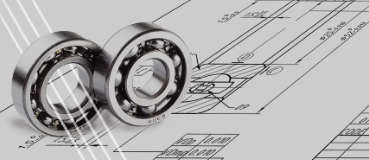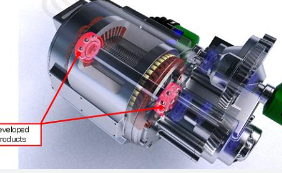Unleashing the Power of Deep Groove Ball Bearings
Discover how to unleash the power of deep groove ball bearings!
Learn proper installation, maintenance, and troubleshooting techniques to ensure optimal performance and reliability.
As an author, I am passionate about sharing the importance of proper installation and maintenance of deep groove ball bearings.
Did you know that these bearings are widely used in a range of applications, from automotive to industrial machinery?
In this article, we will explore how to unleash their power and ensure long-term performance and reliability.
Deep groove ball bearings are essential components in many machines and devices, from cars to conveyor belts.
Proper installation, regular maintenance, and effective troubleshooting techniques are crucial for ensuring optimal performance and reliability.
Follow these guidelines to minimize downtime, reduce maintenance costs, and extend the lifespan of your machinery.
Whether you're a mechanic, engineer, or simply interested in learning more about deep groove ball bearings, this article has something for you.
Discover how to avoid common issues, troubleshoot problems, and unleash the power of these versatile bearings.
What are Deep Groove Ball Bearings?

Deep groove ball bearings are a type of radial ball bearings that have a deep groove in their design.
They are widely used in a variety of applications, including machinery, automotive, and aerospace industries.
The design of deep groove ball bearings allows them to carry both radial and axial loads, making them versatile and useful in a range of applications.
The deep groove in the design of these bearings allows the balls to move freely and smoothly along a wider range of motion than other types of bearings.
This enables them to support high-speed and low-friction performance, making them an ideal choice for many applications that require high efficiency and reliability.
The inner and outer races of deep groove ball bearings are typically made of hardened steel, which is designed to withstand high loads and resist wear.
The balls themselves are usually made of steel or ceramic, and they rotate within the races, allowing the bearing to support both radial and axial loads.
The cage that holds the balls in place is usually made of brass, steel, or synthetic materials.
The cage keeps the balls separated and evenly spaced, ensuring that they move smoothly and do not rub against each other, which would cause excessive wear and tear on the bearing.
Deep groove ball bearings are available in a wide range of sizes and configurations, making them suitable for a variety of applications.
They are relatively inexpensive and easy to install, which makes them a popular choice for many industries.
One of the key advantages of deep groove ball bearings is their ability to support high-speed and low-friction performance.
This makes them ideal for applications that require high efficiency and reliability, such as electric motors, machine tools, and automobiles.
In addition to their high-speed performance, deep groove ball bearings also have excellent durability and can withstand heavy loads and high temperatures.
This makes them suitable for use in harsh environments, such as in industrial machinery and marine applications.
Overall, deep groove ball bearings are a reliable and versatile type of bearing that is widely used in many different applications.
Their ability to support both radial and axial loads, combined with their high-speed and low-friction performance, makes them a popular choice for many industries.
Advantages of deep groove ball bearings

A. Reduced friction and energy consumption
The design of deep groove ball bearings allows for smooth and efficient rotation, which reduces friction and energy consumption.
This makes them ideal for high-speed applications, as less energy is required to keep them rotating.
B. Higher speed capabilities
The deep groove design of these bearings allows for higher speed capabilities compared to other types of bearings.
This is due to the reduced friction and energy consumption, as well as the ability to maintain smooth and consistent rotation at high speeds.
C. Improved load-carrying capacity
Deep groove ball bearings can carry both radial and axial loads, which improves their load-carrying capacity.
This makes them ideal for applications that require high load-bearing capabilities, such as heavy machinery or equipment.
D. Lower noise and vibration levels
The smooth and efficient rotation of deep groove ball bearings also reduces noise and vibration levels.
This makes them ideal for applications that require quiet operation, such as in the automotive or aerospace industries.
E. Cost-effectiveness
Deep groove ball bearings are relatively inexpensive and easy to install, which makes them a cost-effective choice for many applications.
They also have a long service life and require minimal maintenance, which further reduces costs in the long run.
Applications of deep groove ball bearings

A. Use in automobiles
Deep groove ball bearings are commonly used in automobiles for a variety of applications, including wheel bearings, transmission bearings, and engine bearings.
The ability of deep groove ball bearings to support both radial and axial loads makes them ideal for use in high-speed and high-load applications, such as in automotive engines and transmissions.
They also have excellent durability and can withstand the harsh conditions found in automotive environments, such as high temperatures and exposure to dirt and debris.
B. Use in industrial machinery
Deep groove ball bearings are widely used in industrial machinery for a variety of applications, including conveyor systems, pumps, and gearboxes.
Their ability to support high loads and high speeds makes them ideal for use in heavy machinery, where they can provide reliable and efficient operation.
They are also able to withstand the harsh environments found in industrial settings, such as exposure to dust, dirt, and contaminants.
C. Use in household appliances
Deep groove ball bearings are used in a range of household appliances, such as washing machines, dishwashers, and vacuum cleaners.
They provide smooth and efficient operation, which reduces noise and vibration levels, making them ideal for use in household appliances where quiet operation is important.
They also have a long service life and require minimal maintenance, which makes them a cost-effective choice for manufacturers of household appliances.
How to choose the right deep groove ball bearing
A. Understanding the load and speed requirements
One of the most important factors in choosing the right deep groove ball bearing is understanding the load and speed requirements of the application.
The load requirements include both radial and axial loads, as well as any shock or impact loads that may occur.
The speed requirements refer to the maximum rotational speed that the bearing will be subjected to.
By understanding these requirements, the appropriate bearing can be selected that can handle the specific load and speed requirements of the application.
B. Selecting the appropriate size and type
Deep groove ball bearings are available in a wide range of sizes and types, which can make selecting the appropriate one challenging.
The size of the bearing is determined by the shaft diameter and housing bore, and it is important to select a bearing that fits properly to ensure proper operation.
The type of bearing is also important, as there are many variations available, including open or sealed designs, different cage materials, and different types of lubrication systems.
By selecting the appropriate size and type of bearing, the application can be optimized for maximum efficiency and reliability.
C. Considering the operating conditions
The operating conditions of the application are also an important consideration when selecting the right deep groove ball bearing.
This includes factors such as temperature, humidity, and exposure to contaminants or corrosive substances.
By considering the operating conditions, the appropriate materials and design features can be selected to ensure that the bearing can withstand the specific conditions of the application.
Installation and maintenance of deep groove ball bearings
A. Proper installation techniques
Proper installation is critical for the long-term performance and reliability of deep groove ball bearings.
The following techniques should be followed:
1.Cleanliness: Ensure that the installation area and the bearing components are clean and free of debris, dust, or other contaminants.
2.Handling: Handle the bearing carefully and avoid any impact or shock that may damage the bearing components.
3.Fit: Ensure that the bearing fits properly into the housing or on the shaft.
Use appropriate tools such as a press to avoid any damage to the bearing components.
4.Lubrication:Apply the appropriate amount of lubrication to the bearing components before installation to ensure proper operation and prevent any damage due to lack of lubrication.
B. Regular maintenance and inspection
Regular maintenance and inspection are essential for ensuring the long-term performance and reliability of deep groove ball bearings.
The following maintenance and inspection procedures should be followed:
1.Lubrication:Ensure that the bearing components are properly lubricated at regular intervals to prevent damage due to lack of lubrication.
2.Cleaning: Regularly clean the bearing components and surrounding area to prevent any debris or contaminants from entering the bearing and causing damage.
3.Inspection: Regularly inspect the bearing components for any signs of wear or damage, such as cracks, corrosion, or excessive wear.
4.Replacement:Replace any damaged or worn bearing components promptly to avoid any further damage or failure.
C. Troubleshooting common issues
Some common issues that may occur with deep groove ball bearings include excessive noise, vibration, or heat.
The following troubleshooting techniques can be used to identify and resolve these issues:
1.Excessive noise: Excessive noise may be caused by a variety of factors, such as incorrect installation, lack of lubrication, or damaged components.
To troubleshoot this issue, check for any visible signs of damage to the bearing components and ensure that the bearing is installed correctly and lubricated properly.
2.Vibration: Vibration may be caused by several factors, such as misalignment, unbalanced loads, or worn components.
To troubleshoot this issue, inspect the bearing components for any signs of wear or damage, check for proper alignment, and balance any loads if necessary.
3.Heat: Excessive heat may be caused by overloading, lack of lubrication, or incorrect installation.
To troubleshoot this issue, inspect the bearing components for any signs of damage or wear, ensure that the bearing is properly lubricated, and check for proper installation and alignment.
Conclusion
By following proper installation, maintenance, and troubleshooting techniques, you can unleash the power of deep groove ball bearings and ensure long-term performance and reliability.
Don't miss out on the opportunity to optimize your machinery and minimize downtime!





